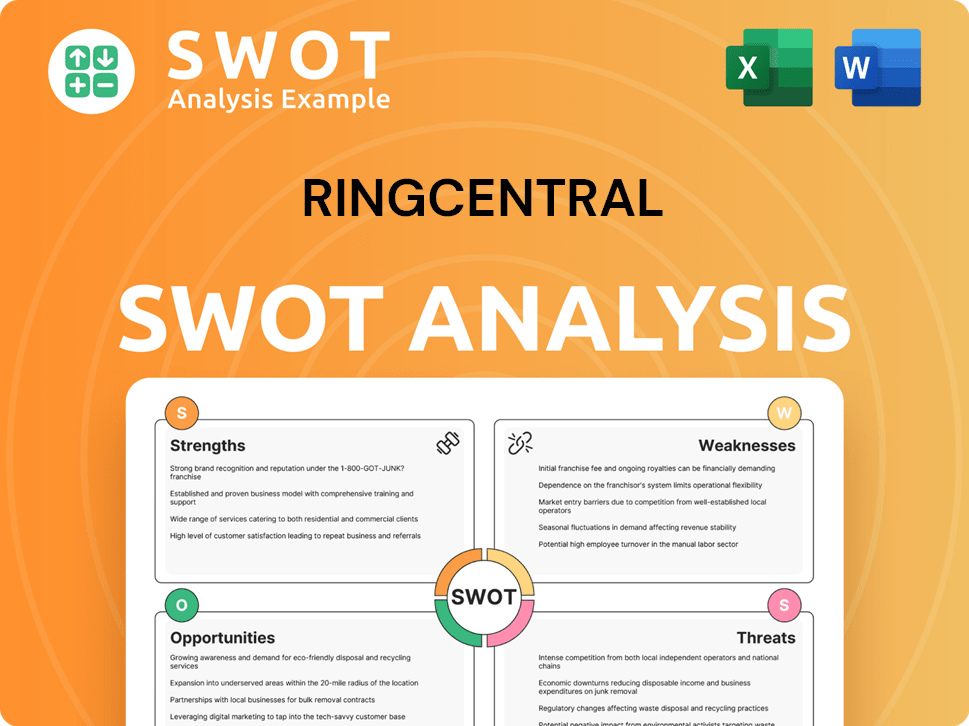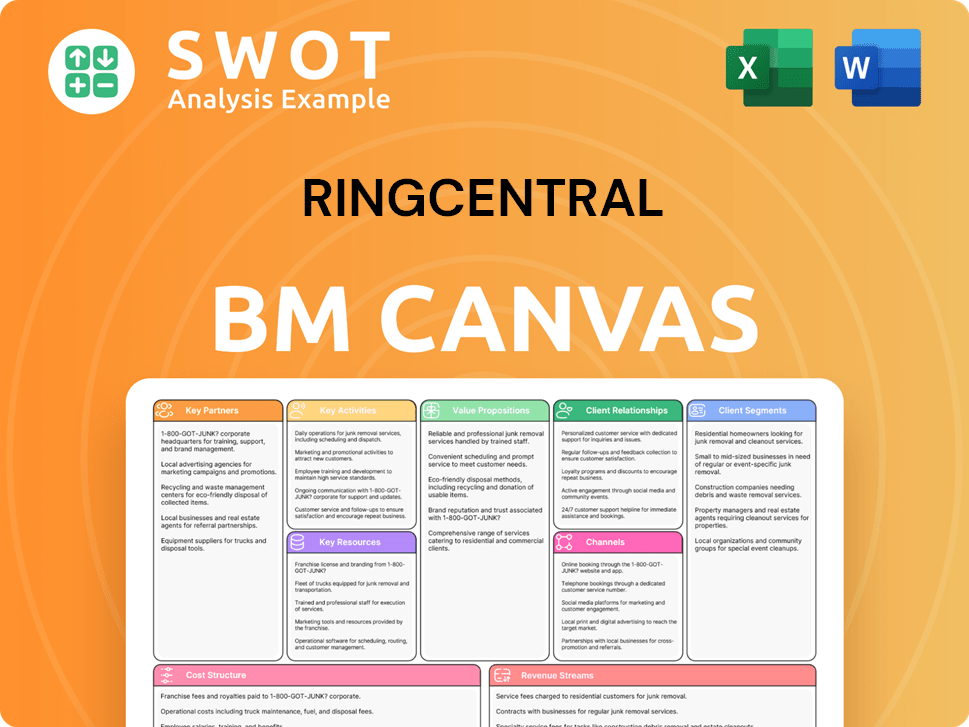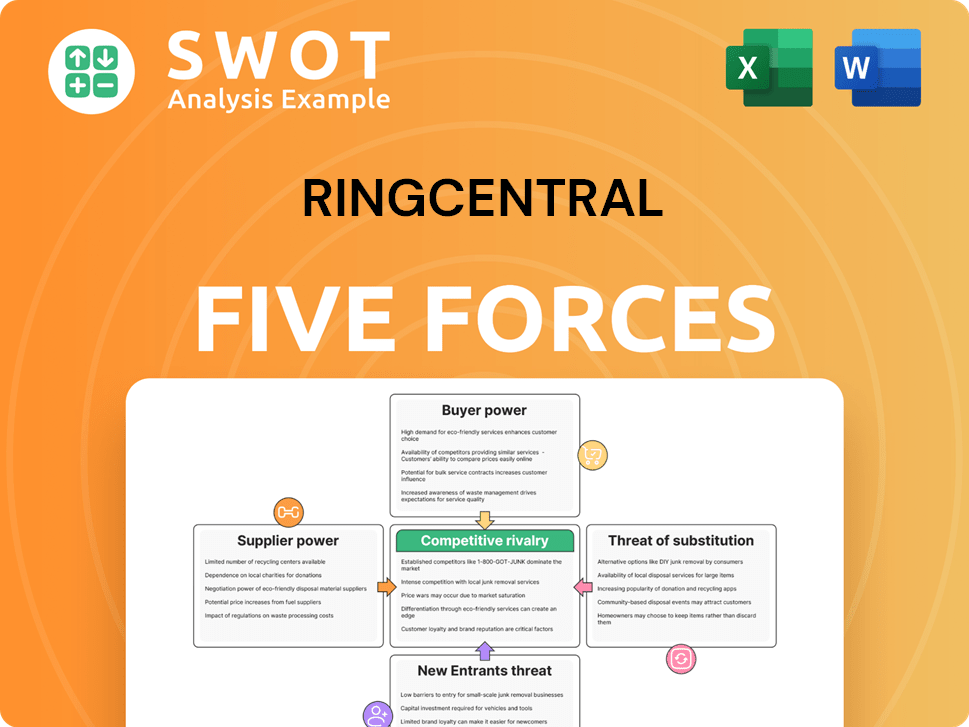RingCentral Bundle
How Did RingCentral Revolutionize Business Communication?
In a world increasingly reliant on seamless connectivity, RingCentral stands as a pioneer in cloud communications. From its humble beginnings, this RingCentral SWOT Analysis shows how the company has redefined how businesses connect and collaborate. Discover the fascinating story of a company that transformed the business phone system.

RingCentral's journey, starting in 1999 as Ring Zero Systems, Inc., reflects a strategic shift from traditional, on-premise systems to the cloud. This VoIP provider quickly recognized the need for flexible and accessible communication solutions, leading to its evolution into a major player in cloud communications. This article will delve into the brief history of RingCentral, exploring its key milestones, product evolution, and its lasting impact on business communication.
What is the RingCentral Founding Story?
The RingCentral history began on September 14, 1999. It was founded by Vlad Shmunis and Vlad Vendrow. They saw an opportunity to revolutionize business communications.
Shmunis, with his software development background, recognized the potential of the internet. Vendrow provided the technical expertise. Together, they aimed to solve the problems associated with traditional PBX systems.
The initial focus of the RingCentral company was on cloud-based fax services and virtual PBX solutions. They used the internet to offer more affordable and scalable communication tools. Their first product was a virtual phone system. This system allowed businesses to manage calls, faxes, and voicemails online, without expensive on-premise equipment.
Early funding came from bootstrapping and seed rounds. The founders were committed to their innovative concept. A key challenge was convincing businesses to trust a cloud-based communication solution.
- The name, RingCentral, was chosen to convey a central hub for business communications.
- The founders' expertise in software development and networking was crucial.
- They overcame early hurdles to establish a foothold in the cloud communications market.
RingCentral SWOT Analysis
- Complete SWOT Breakdown
- Fully Customizable
- Editable in Excel & Word
- Professional Formatting
- Investor-Ready Format

What Drove the Early Growth of RingCentral?
The early growth of the company, now known as RingCentral, was marked by strategic product development and market expansion. Starting with basic virtual PBX and fax services, the company quickly added enhanced voice features, call management tools, and integrations. This initial phase focused on building a solid foundation for a growing customer base, primarily targeting small businesses seeking flexible communication solutions.
A key development was the shift from a virtual PBX provider to a comprehensive unified communications platform. This move addressed the market's demand for integrated solutions. The company strategically entered new markets and expanded its reach within the United States. This evolution was supported by capital raises, allowing for accelerated product development and marketing efforts.
During this time, the company demonstrated strong growth, including increased subscriber numbers and recurring revenue. Despite the emergence of new cloud communication providers, the company maintained its competitive edge through continuous innovation and a focus on customer experience. Investing in its cloud architecture and API platform was crucial.
The company's product evolution included adding features like call recording, advanced call routing, and integrations with CRM systems. These enhancements improved its value proposition for businesses. The company's focus on innovation helped it to stay competitive in the dynamic cloud communications market. The company also focused on the customer experience.
Investing in its proprietary cloud architecture and developing a robust API platform were pivotal decisions. This strategic shift positioned the company as a platform provider, significantly shaping its trajectory. This approach allowed for seamless integrations with other business applications, which was a key differentiator. For more insights, check out the Marketing Strategy of RingCentral.
RingCentral PESTLE Analysis
- Covers All 6 PESTLE Categories
- No Research Needed – Save Hours of Work
- Built by Experts, Trusted by Consultants
- Instant Download, Ready to Use
- 100% Editable, Fully Customizable

What are the key Milestones in RingCentral history?
The RingCentral company's journey, from its inception to its current standing, showcases a series of significant milestones. The evolution of this VoIP provider highlights strategic decisions and technological advancements that have shaped its position in the cloud communications landscape. Understanding the RingCentral history provides insights into its growth and impact on business communication.
| Year | Milestone |
|---|---|
| 1999 | The company was founded, marking the early days of RingCentral and its entry into the telecommunications industry. |
| 2003 | The company launched its first cloud-based phone system, establishing its foundation as a business phone system provider. |
| 2013 | RingCentral went public with its IPO, a pivotal moment that fueled its expansion and market presence. |
| 2020 | RingCentral acquired several companies to expand its product portfolio and enhance its market position. |
| 2023 | RingCentral continues to innovate and expand its offerings, focusing on integrated communication solutions. |
A key innovation was the development of its unified communications platform, which integrated voice, video, and messaging into a single, user-friendly interface. This all-in-one approach distinguished RingCentral in the market, providing businesses with a comprehensive communication solution. For more information on who uses this platform, check out this article on the Target Market of RingCentral.
This platform combined voice, video conferencing, team messaging, and contact center capabilities, offering a comprehensive communication solution.
The shift to a cloud-based architecture allowed for greater scalability, flexibility, and cost-effectiveness compared to traditional on-premise systems.
RingCentral has developed robust integration capabilities with popular business applications like Salesforce and Microsoft Teams, enhancing workflow efficiency.
The company has incorporated AI-driven features, such as chatbots and analytics, to improve customer service and operational insights.
RingCentral prioritized mobile accessibility, allowing users to communicate and collaborate from anywhere, enhancing business agility.
The company has continuously improved its security protocols, including end-to-end encryption, to protect sensitive business communications.
The company has faced challenges from market competition, technological shifts, and the need to scale its services effectively. Adapting to evolving customer needs and maintaining a competitive edge in the cloud communications market has been an ongoing focus.
The VoIP provider faces intense competition from established telecom companies and other cloud-based communication platforms, requiring continuous innovation and differentiation.
The rapid evolution of technology, including AI and mobile communication, demands that RingCentral continually adapt its products and services to meet changing customer expectations.
As the company grows, ensuring the reliability and scalability of its infrastructure and services to handle increased user demands is a constant challenge.
The increasing sophistication of cyber threats requires RingCentral to continuously enhance its security measures to protect customer data and maintain trust.
Economic fluctuations can impact business spending on communication services, requiring RingCentral to adapt its pricing and marketing strategies to maintain revenue growth.
Changes in telecommunications regulations globally can impact the company's operations and require adjustments to ensure compliance and maintain service offerings.
RingCentral Business Model Canvas
- Complete 9-Block Business Model Canvas
- Effortlessly Communicate Your Business Strategy
- Investor-Ready BMC Format
- 100% Editable and Customizable
- Clear and Structured Layout

What is the Timeline of Key Events for RingCentral?
The RingCentral history showcases a journey of innovation and expansion in the cloud communications sector. Founded in 1999 as Ring Zero Systems, Inc., the company rebranded to RingCentral in 2003 and launched its virtual PBX service. Key milestones include the introduction of its mobile app in 2008, the IPO in 2013, and the launch of RingCentral Office in 2015. Strategic partnerships like the one with Avaya in 2019, along with significant growth during the 2020 remote work surge, have further shaped the
| Year | Key Event |
|---|---|
| 1999 | Founded as Ring Zero Systems, Inc. |
| 2003 | Rebrands to RingCentral and launches its virtual PBX service. |
| 2008 | Introduces its first mobile app, extending cloud communications to smartphones. |
| 2013 | Goes public on the New York Stock Exchange (NYSE: RNG). |
| 2015 | Launches RingCentral Office, a unified communications platform. |
| 2019 | Forms a strategic partnership with Avaya, expanding its enterprise market reach. |
| 2020 | Experiences significant growth due to the surge in remote work during the pandemic. |
| 2022 | Continues to enhance its AI-powered features for communication and collaboration. |
| 2024 | Focuses on expanding its global footprint and strengthening its contact center solutions. |
RingCentral is heavily investing in artificial intelligence (AI). This includes features like AI-powered meeting summaries, noise reduction, and intelligent routing for contact centers. These enhancements aim to improve productivity and user experience for all users. This focus on AI reflects a broader industry trend towards intelligent communication solutions.
The company plans to expand its global market presence, especially in Europe and Asia. This includes tailoring offerings to meet regional compliance and language requirements. This expansion strategy is crucial for capturing new market opportunities. This also helps the company grow its customer base.
Analyst predictions for the UCaaS market indicate sustained growth. The market size is projected to exceed $100 billion by 2028. This presents a favorable environment for RingCentral and its continued expansion. This growth is driven by the increasing adoption of cloud-based communication solutions.
RingCentral is committed to empowering businesses with flexible and intelligent communication solutions. The company's innovation roadmap includes deeper integrations with business applications. It also involves the development of more vertical-specific solutions to cater to diverse industry needs. This approach aligns with the vision of democratizing advanced communication tools.
RingCentral Porter's Five Forces Analysis
- Covers All 5 Competitive Forces in Detail
- Structured for Consultants, Students, and Founders
- 100% Editable in Microsoft Word & Excel
- Instant Digital Download – Use Immediately
- Compatible with Mac & PC – Fully Unlocked

Related Blogs
- What is Competitive Landscape of RingCentral Company?
- What is Growth Strategy and Future Prospects of RingCentral Company?
- How Does RingCentral Company Work?
- What is Sales and Marketing Strategy of RingCentral Company?
- What is Brief History of RingCentral Company?
- Who Owns RingCentral Company?
- What is Customer Demographics and Target Market of RingCentral Company?
Disclaimer
All information, articles, and product details provided on this website are for general informational and educational purposes only. We do not claim any ownership over, nor do we intend to infringe upon, any trademarks, copyrights, logos, brand names, or other intellectual property mentioned or depicted on this site. Such intellectual property remains the property of its respective owners, and any references here are made solely for identification or informational purposes, without implying any affiliation, endorsement, or partnership.
We make no representations or warranties, express or implied, regarding the accuracy, completeness, or suitability of any content or products presented. Nothing on this website should be construed as legal, tax, investment, financial, medical, or other professional advice. In addition, no part of this site—including articles or product references—constitutes a solicitation, recommendation, endorsement, advertisement, or offer to buy or sell any securities, franchises, or other financial instruments, particularly in jurisdictions where such activity would be unlawful.
All content is of a general nature and may not address the specific circumstances of any individual or entity. It is not a substitute for professional advice or services. Any actions you take based on the information provided here are strictly at your own risk. You accept full responsibility for any decisions or outcomes arising from your use of this website and agree to release us from any liability in connection with your use of, or reliance upon, the content or products found herein.